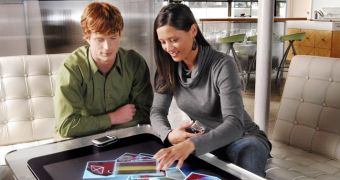Microsoft is currently cooking the next generation of its surface computing product. Microsoft Surface 2.0, codenamed Second Light, is the evolution of the tabletop computer already available to select business customers around the world at prices over $10,000 per unit. Surface 2.0 is also being built with corporate customers in mind, although the Redmond company has promised that it aims to make surface computers (for every surface, be it vertical or horizontal) a ubiquitous technology.
According to BBC News, Surface 2.0 is anywhere from two to three years away. Microsoft already presented a demo of Second Light at the Professional Developers Conference in Los Angeles at the end of October 2008 (video embedded at the bottom of this article). One of the major enhancements will be the addition of a projector on top of the hardware originally available. In this regard, Second Light will be able to not only offer content on the touch-screen but also on an additional screen overlaying on top of the first.
Work on Surface debuted all the way back in 2004, when Microsoft was struggling to build a new user interface framework on top of DirectX. The Surface team abandoned early plans, despite building a total of three UI frameworks, when they were presented with a GPU-accelerated UI framework labeled Avalon, which ended up developing into the Windows Presentation Framework (WPF).
“Even in those early stages everyone was pretty amazed at the demos and what the API provided. The “RenderTransform” on Avalon allowed you to rotate parts of your app to face arbitrary directions. Another part of Avalon that encouraged us to use it was “RoutedEvents.” This lets us send events from the Surface input hardware right to the appropriate application UI components. It was almost as if they had Surface in mind even before anyone ever heard of Surface,” revealed Kevin Kennedy, Microsoft Surface lead software design engineer.
Microsoft Surface 2.0 will also bring to the table an array of new infrared sensors in addition to the cameras currently included in the tabletop computer. The new sensors will serve to detect and interpret user actions and gestures even if there is no touch contact. In this regard, with the evolution of Surface, Microsoft is also taking its vision of Natural User Interfaces to the next level.
“We followed the WPF team as they designed a brand new UI framework, implemented it, tested it, supported developers using it, created tools for it, and continue to maintain it. Had we gone ahead and implemented our own UI framework we would have had to do a lot of the same. I’d much rather be writing cool Surface applications,” Kennedy added.

 14 DAY TRIAL //
14 DAY TRIAL //